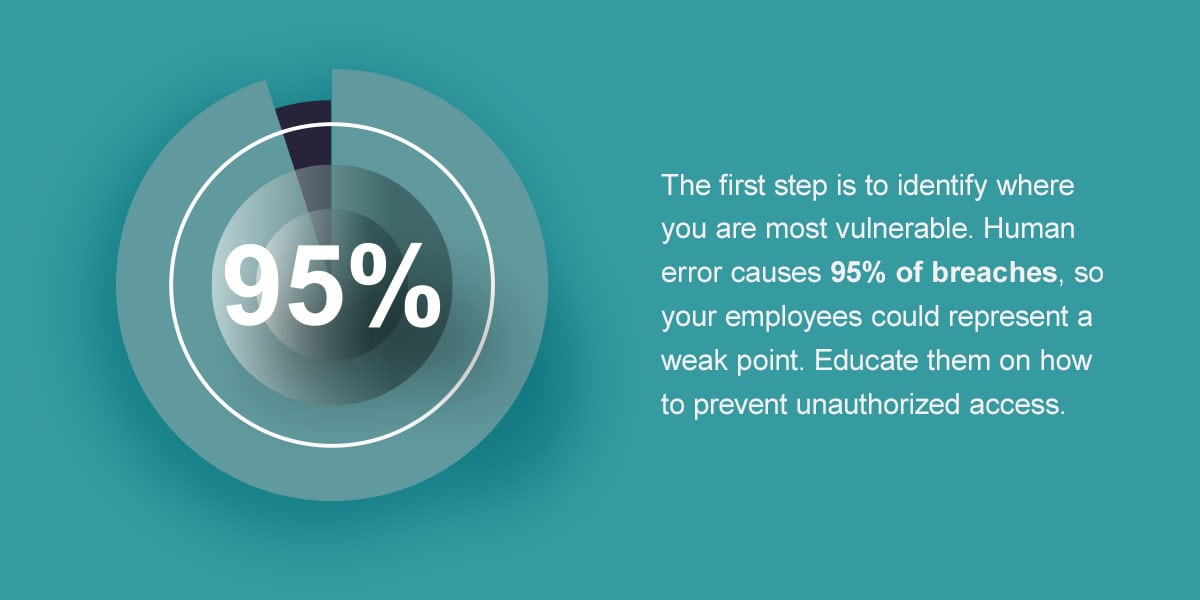What Is a Cybersecurity Incident Response Plan, and Why Do You Need One?
Cyberattacks and breaches are a reality for most businesses, and 48.8% of C-suite and other executives expect the number and size of these events to increase. Cybersecurity incident response is an effective method to curtail — or even prevent — the effects of a cyber incident.
Many believe small and medium businesses are at less risk of these threats. However, 83% of SMBs are financially unprepared for cyberattack recovery, making an incident response plan crucial for small businesses. Getting strategic about cybersecurity in the current threat landscape should shift from being reactive to proactive, and a cybersecurity incident response plan is a significant part of this approach.
What Is a Cybersecurity Incident Response Plan?
A cybersecurity incident response plan outlines the processes and procedures your organization should follow when handling a breach. It gives your team a list of protocols everyone can access, detailing all relevant actions your team should take. It should also list specific procedures to protect customer data and recover systems after your team has identified and mitigated a threat.
Your CIRP should meet three primary criteria:
- Outline procedures to detect malicious attempts to access your networks.
- Provide protocols detailing how to respond to an incident.
- Take your team through the steps to limit a breach’s consequences.
Why Do You Need an Incident Response Plan?
An effective cybersecurity incident response plan is no longer a luxury but a necessity. Over 60% of small businesses experienced a cyberattack in 2022, and experts predict cybercrime costs will grow 15% annually, reaching $10.5 trillion by 2025. A CIRP could mean the difference between a success and an expensive lesson. Incident response is important because it guides your actions, helps you stay calm, and supports real-time strategic decisions.
Compared to the expense of a cyber breach, an incident response plan is a low-cost option that yields significant benefits. It empowers organizations to maintain more robust cybersecurity. Here are some benefits of an incident response plan.
- Reduce costs: In addition to the cost of the incident, you must also incur investigation expenses. A CIRP can do more than help you during an attack. It can prevent one, as part of your incident response protocol includes identifying potential threats. Planning can also help you find and reduce unnecessary security expenditures.
- Maintain compliance: Many industries require compliance with various data security regulations, and a breach can result in costly fines. Often, organizations must complete cybersecurity assessments, which complement those you perform when testing and reviewing your incident response plan.
- Contain cyberattacks: When everyone on your team understands their roles and responsibilities in a breach, they can act quickly and decisively to contain the situation and minimize any damage.
- Minimize downtime: A systematic and comprehensive response plan reduces downtime so you can resume operations and minimize your losses.
- Recover well: A detailed CIRP provides your team with protocols to recover from a breach with minimal damage or regulatory implications.
- Analyze and improve: Understanding what happened can give your team valuable information on how to patch the vulnerabilities that enabled the attack and improve your plan further.
- Inform security awareness training: Everyone in your organization should have security awareness training. Your CIRP provides a blueprint for creating a cohesive team that understands how to respond to online threats.
- Build trust: A robust incident response plan builds trust with your stakeholders and protects your reputation.
How to Create a Successful Incident Response Plan
Your CIRP must be detailed and actionable to ensure you can respond effectively to a cyber incident. Though the process will differ depending on your organization and its needs, here are some fundamental steps you can take.
1. Update Your Cybersecurity Policy
Your CIRP should align with your overarching cybersecurity policy. Creating your response plan is the perfect time to make or revisit your policy and include specific designations.
2. Choose an Incident Response Team
A cybersecurity incident affects everyone in your organization, so your response team should include at least one dedicated person from each department. Start with your IT department and assign the responsibility for identifying and containing the source of the attack and instructing other employees to take specific actions.
Depending on your organization’s needs, you should designate a human resources professional to handle internal communications and someone from your customer service team to notify and communicate with your clients. Assign roles to public relations and legal professionals if needed.
One of the most critical considerations for your incident response team is that everyone understands their roles and responsibilities so they can act.
3. Identify Critical Assets and Vulnerabilities

In a cyber incident, your teams must know where to prioritize their efforts. Most organizations have two principal focus areas — assets and flaws. The first step is to identify where you are most vulnerable. Human error causes 95% of breaches, so your employees could represent a weak point. Educate them on how to prevent unauthorized access. Outsourcing impartial experts can help you identify gaps in your cybersecurity profile.
Second, identify your critical assets, like customer data or proprietary information. When you have a clear picture of these two areas, your team will know where and how to focus their efforts during a cyber incident.
4. Involve External Experts and Back up Resources
Even if you have an in-house IT security team, a cyber incident’s effects could require external support. A managed service provider with cybersecurity experience and capabilities could be instrumental in auditing and repairing the situation. In addition, they can train your employees in line with your unique business requirements. Conduct thorough research and find a team of trusted experts to elevate your cybersecurity profile and assist with incident response measures when needed.
Having backup resources is also essential so you know you can move all your critical data quickly when needed. Your MSP can help you find the best data backup option and set up automatic backups to help keep your data safe.
5. Create a Detailed Checklist
Amid a cyber incident, your time will likely have a lot to remember, and a checklist removes the guesswork from this high-stress time. Your response will differ depending on your cybersecurity needs and profile, but example steps could include the following.
- Identify: Consider the cyber threats in the current landscape and identify those that could impact your organization.
- Assign: Choose the best people to fill the various roles and responsibilities outlined in your CIRP.
- Contain: Ensure you contain any incident quickly to isolate the threat.
- Eradicate: Remove the threats from your network and devices.
- Communicate: Prepare public statements to notify the relevant parties about the incident and minimize reputational damage.
- Recover: Outline the necessary steps to return your systems to their pre-incident state.
- Learn: Take as much information as possible after the incident to identify errors and vulnerabilities and update your plan to prevent future attacks.
6. Perform Regular Testing and Updates
A tried-and-tested CIRP is more valuable than a theoretical one. Discuss creating a test environment with your MSP to identify and address weaknesses in your response plan before an incident occurs. The cybersecurity landscape is ever-changing, so updating your CIRP to reflect new threats is also vital. A CIRP is a flexible document — be adaptable when reviewing yours.
Take Your Cybersecurity Incident Response to the Next Level With Framework IT
Cyber threats constantly evolve, and robust cybersecurity protocols can protect your organization from a cyber incident’s cost, downtime, and reputational damage. A cybersecurity incident response plan is one tool, but a preventive approach is critical. Framework IT can help you secure your data, starting with minimum security measures and building from there.
Partnering with us grants you automatic access to off-site storage, on-site backups, security awareness training, and other services designed to strengthen your cybersecurity profile.
Contact us to learn how to get out of the cycle of reactive IT today.



